

Jaws is a 1975 horror thriller film directed by Steven Spielberg, based on Peter Benchley's best-selling novel of the same name, which was inspired in turn by the Jersey Shore Shark Attacks of 1916. In the film, the police chief of Amity Island, a summer resort town, tries to protect beachgoers from the predations of a huge great white shark by closing the beach, only to be overruled by the town council, who want the beaches to remain open to draw a profit from tourists. After several attacks, the police chief enlists the help of a marine biologist and a professional shark hunter to kill the shark. The film stars Roy Scheider as police chief Martin Brody, Richard Dreyfuss as marine biologist Matt Hooper, Robert Shaw as the shark hunter Quint, Lorraine Gary as Brody's wife Ellen Brody, and Murray Hamilton as Mayor Vaughn.
Jaws is regarded as a watershed film in motion picture history, the father of the summer blockbuster movie and one of the first "high concept" films.[2][3] Due to the film's success in advance screenings, studio executives decided to distribute it in a much wider release than ever before. The Omen followed suit a year later in the summer of 1976, and then Star Wars one year later in 1977, cementing the notion for movie studios to distribute their big-release action and adventure pictures (commonly referred to as tentpole pictures) during the summer season. The film was followed by three sequels, none of which Spielberg participated in: Jaws 2 (1978), Jaws 3-D (1983) and Jaws: The Revenge (1987).http://en.wikipedia.org/wiki/Jaws_(film)

The fear of sharks has been fueled by relatively rare instances of unprovoked attack, such as the Jersey Shore Shark Attacks of 1916, and by sensationalized fiction and film, such as the Jaws series. The creator of the Jaws phenomenon, the late Peter Benchley, had himself in recent years attempted to dispel the myth of sharks being man-eating monsters.
According to the ISAF, the number of shark attacks worldwide increased to 62 in 2006 from 61 in 2005, but the number of those proving deadly was unchanged at four. This is far below the 79 attacks, 11 of them fatal, in 2000. The United States had more reported shark attacks than any other nation, with 38 in 2006; down from 40 in 2005 and well below the 53 recorded in 2000. [1] For the same period the Global Shark Attack File recorded 69 unprovoked attacks of which five were fatal.In short, both files indicate the rarity of shark accidents. In comparison, several hundred people die annually from lightning strikes
Why do sharks sometimes attack?
While one should be very cautious with great white sharks, it does not target humans as prey.There are many theories about why sharks sometimes attack people. Some attacking species, such as the Great white shark, may be confusing a human for a seal or other prey animal; this would be typical in the case of an attack against a surfer. The shape of a surfer lying on a board closely resembles a seal from beneath the surface. Also, sharks have sensory organs on their nose to pick up electrical signals, such as those generated by muscles when moving. Often the shark that attacks a human will make only one bite and then go away. This behaviour has many possible explanations, one being that humans don't taste good (or at least, as good), or are lacking the necessary fat, and another being that sharks normally make one swift attack, and then retreat and wait for the victim to die, or exhaust itself, before it comes back to feed. This protects the shark from injury, especially tooth loss, from a wounded and aggressive target; however, it also allows humans time to get out of the water and survive. Another theory is that the electrical receptors, which pick up movement, do not pick up the same signals from a wounded human as they would a wounded seal, and so they are more cautious. In fact, it has recently been shown that surfers do not give off the same electrical signals as seals, or it is thought there would be far more attacks.
How to avoid an attack or defend against one
Threat display of a grey reef shark. The postures become more exaggerated as the danger perceived by the shark increases.Many shark species are known to show a shark threat display when feeling threatened, that is most normally a curvature of the shark in the form of an "S" shape, jerky movement and erratic swimming and jaw gaping, when these signs are displayed it is ill-advised to remain in the vicinity of the shark. The shark feels threatened and will either attack or run away. To minimise the risk of an attack drop speared fish or other food, move away calmly with purposeful movement while still facing and looking at the shark, stay close to the bottom or reef and close to any dive buddy, do not corner the shark. If the shark attacks, comes close or even bites, hit it in the gills, eyes and nose or just hit towards it to drive it away.
http://en.wikipedia.org/wiki/Shark_attack
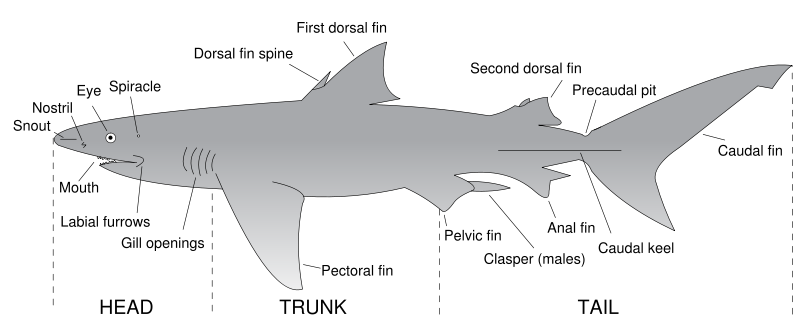
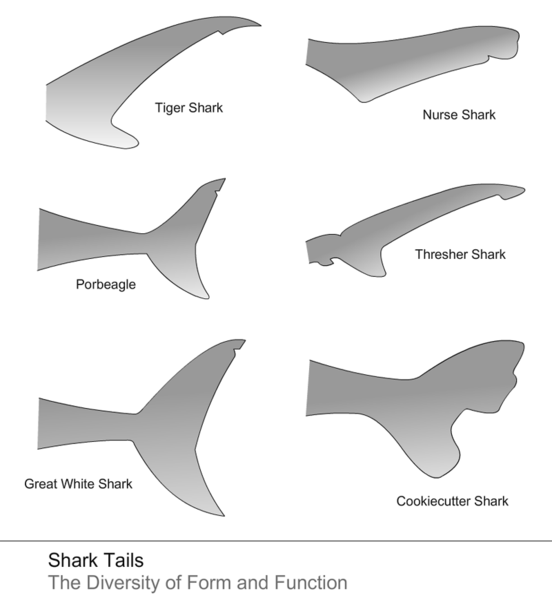
Sharks
http://commons.wikimedia.org/wiki/Image:Parts_of_a_shark.svg
Though the United States has only recently begun to appreciate the merits of this fish, other cultures have eaten shark for eons. Some of the more popular shark species are leopard, mako, soupfin and thresher. Sharks marketed for food range in size from 15 to 120 pounds. Though some of the smaller ones are sold whole, fillets, steaks or chunks are the more common market forms. The shark's flavorful, lowfat flesh is dense and meatlike. Because of its metabolism, however, it has a tendency to smell of ammonia. This off-putting odor can easily be eliminated by soaking the fish in milk or acidulated water. Shark can be prepared in a variety of ways including broiling, grilling, baking, poaching and frying. It's also delicious in soups, and cold, cooked shark can be used in salads. See also dogfish; fish; shark's fin.
List of fatal, unprovoked shark attacks in the United States by decade
http://en.wikipedia.org/wiki/List_of_fatal,_unprovoked_shark_attacks_in_the_United_States_by_decade
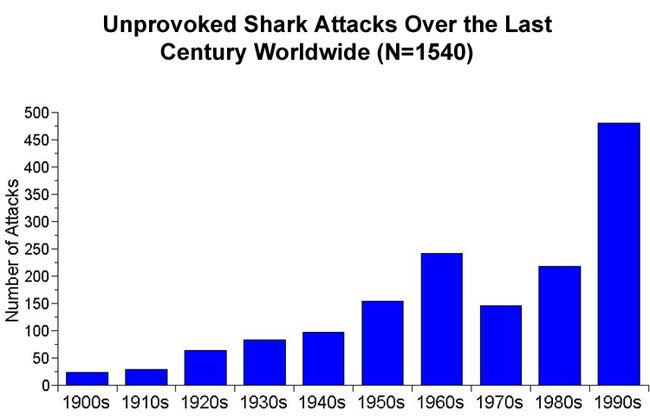
International Shark Attack File
http://www.flmnh.ufl.edu/fish/Sharks/ISAF/ISAF.htm
Twenty Shark Facts
http://scuba.about.com/cs/sharks/a/20sharkfacts.htm
1. Great white sharks grow about 10 inches per year. Great whites can grow to mature lengths of 12 to 14 feet.
2. New teeth are constantly being formed in rows in a shark's jaw. Shark's teeth are normally replaced every eight days.
3.Some species of sharks can shed as many as 30,000 teeth in their lifetime.
4. Whale sharks have approximately 300 rows of teeth, with hundreds of tiny teeth in each row.
5. Dried shark skin (shagreen) was used in the past as sandpaper. In Germany and Japan, shark skin was used on sword handles for a non-slip grip.
6. In 1937, shark liver oil was discovered to be rich in vitamin A. Sharks were hunted for the vitamin until 1950, when a synthesizing method was developed for vitamin A.
7. The average life span of a shark is 25 years, but some sharks can live to be 100.
8. The dogfish sharks are named for their tendency to attack their prey as a pack of wild dogs would.
9. Great white sharks can go as long as three months without eating.
10. Not all sharks have to be in continuous motion to breathe.
11. Bull sharks can tolerate a wide range of salinity and are often found in freshwater rivers and lakes in Africa and South America.
12. More people are killed each year by dogs, pigs and deer than by shark attacks.
13. The pygmy shark has a maximum length of 11 inches.
14. Sharks have no bones. A shark's skeleton is made up of cartilage.
15. There are more than 340 known species of sharks.
16. Sharks first appeared in the fossil record over 400 million years ago.
17. A significant physical trait that separates a modern shark from an ancient shark is the protrusile jaw, which gives the modern shark more biting force.
18. Sharks can generate about six and a half tons per square inch of biting force.
19. A shark's skin is embedded with dermal denticles, which resemble teeth.
20. The shortfin mako shark is probably the fastest fish in the ocean, clocked at about 60 mph.
Ultimate Guide to Sharks: A living tooth
Shark Facts: Attack Stats, Record Swims, More
http://news.nationalgeographic.com/news/2005/06/0613_050613_sharkfacts.html
The United States averages just 16 shark attacks each year and slightly less than one shark-attack fatality every two years. Meanwhile, in the coastal U.S. states alone, lightning strikes and kills more than 41 people each year.
Which just goes to show that sharks enjoy a reputation that is arguably more fearsome than their bite. Read on for more surprising shark facts compiled by National Geographic News:
Each year there are about 50 to 70 confirmed shark attacks and 5 to 15 shark-attack fatalities around the world. The numbers have risen over the past several decades but not because sharks are more aggressive: Humans have simply taken to coastal waters in increasing numbers.
• Over 375 shark species have been identified, but only about a dozen are considered particularly dangerous. Three species are responsible for most human attacks: great white (Carcharodon carcharias), tiger (Galeocerdo cuvier), and bull (Carcharhinus leucas) sharks.
• While sharks kill fewer than 20 people a year, their own numbers suffer greatly at human hands. Between 20 and 100 million sharks die each year due to fishing activity, according to data from the Florida Museum of Natural History's International Shark Attack File. The organization estimates that some shark populations have plummeted 30 to 50 percent.
• The shortfin mako (Isurus oxyrinchus) is often recognized as the world's speediest shark. It has been clocked at speeds of up to 20 miles an hour (32 kilometers an hour) and can probably swim even faster than that. Makos are fast enough to catch even the fleetest fish, such as tuna and swordfish.
• The largest shark is the whale shark (Rhincodon typus), which can grow to 60 feet (20 meters) long. The gentle giant eats tiny plankton.
• Among the smallest shark species is the deepwater dogfish shark (Etmopterus perryi). A habitué of the Caribbean, the dogfish measures a less-than-intimidating 8 inches (20 centimeters) in length.
• Sharks are known as eating machines. But because many species are cold-blooded, some sharks eat only about 2 percent of their body weight each day. That's a bit less than humans typically eat.
• While scientists still have much to learn about shark migration, researchers do know that some species get around. Blue sharks (Prionace glauca), for example, roam the North Atlantic on journeys of 1,200 to 1,700 nautical miles (2,220 to 3,145 kilometers). After one record-breaking blue was tagged off New York, it swam 3,740 nautical miles (6,919 kilometers) to Brazil.
• Some sharks must swim constantly to "breathe" oxygen from water passing through their gills. Other species can achieve this while stationary.
• Sharks do not sleep. Rather, they experience alternating periods of activity and rest.
Sharks are among Earth's most ancient animals. The fossil record dates ancestors of modern sharks to as far back as 400 million years ago. Shark species have changed relatively little during that time span and are sometimes called living fossils.
• Sharks can replace lost teeth in as little as 24 hours and may use thousands of teeth over the course of a lifetime. Ancient teeth are the source of most known shark fossils. (Shark skeletons, which are composed of cartilage, decompose quickly.)
Sharks are diverse reproducers, and their mating has been observed only on rare occasions. Some species are egg-laying (oviparous), while others bear live young (viviparous). Adult sharks do not care for their newborn pups, which are born or hatched as smaller, juvenile versions of their parents.
• Two shark species can survive long periods in fresh water: the bull shark and the speartooth shark (Glyphis glyphis). Both species can engage in river journeys of epic scale. Bull sharks, for example, have been caught 1,700 miles (2,800 kilometers) up the Mississippi River and 2,100 miles (3,480 kilometers) up the Amazon. Neither species, however, lives in landlocked fresh water without ocean access.
• A major cause of shark mortality is "finning," a process in which fishers kill sharks solely to remove their fins. Fins can sell for U.S. $400 per kilogram (U.S. $880 per pound) or more.
Known in China as yu chi or "fish wings," shark fins are used to make the traditional delicacy shark-fin soup. The culturally celebrated but controversial soup is found widely in Asia and will even be on the menu at Hong Kong Disneyland when the park opens in September.
• Sharks are apex predators, and as such, they affect the entire ocean food chain from their position at the top. Because of their dominant role, sharks have long life spans and don't reach sexual maturity until they are 12 to 20 years old. Even then, sharks have low reproductive rates. Such predator populations, once diminished, have a hard time bouncing back.
• As elasmobranches, sharks have skeletons made not of bone but of cartilage, tissue similar to that found in human noses and ears. Cartilaginous skeletons are lighter than bone and help sharks to remain neutrally buoyant (able to float without sinking or rising).
• The media can have a voracious appetite for "shark bites man" stories. The summer of 2001, for example, saw an explosion of shark-attack hype and was even heralded on the cover of Time magazine as the "Summer of the Shark." Yet 2001 was statistically average: The year saw 76 shark attacks and 5 fatalities worldwide, compared to 85 attacks and 12 fatalities in 2000.
• Thirty years ago the blockbuster Jaws brought the terror of shark attack to movie theaters. The record-breaking film, directed by Steven Spielberg and based on a best-selling novel by Peter Benchley, grossed nearly 130 million dollars (U.S.) in the United States alone. The movie arguably made sharks public enemy number one.
Mythbusters: Can sharks detect a drop of blood?
MythBusters: Do sharks have a color preference?
MythBusters: Is shark skin like sandpaper?
Shark Attack Facts - Are Sharks Man Eaters?
http://ezinearticles.com/?Shark-Attack-Facts---Are-Sharks-Man-Eaters?&id=472746
Hollywood and the news media have most definitely given sharks a bad reputation. Movies like “Jaws” and “Deep Blue Sea” and the news media reporting skewed numbers of Shark Attacks from summer 2001 through 2006 have given many people the belief that all sharks are man eaters and that whenever you’re in the ocean you are at risk of a fatal shark attack.
First, let me share some facts regarding shark attacks and information about the Shark species and population.
• In 1999 and 2000 their were more shark attacks then in 2001. Yet the media named by 2001 the “Summer of the Shark”. And most of the Shark bites in 2001 were not for certain Shark bites, they could have been Barracuda or Bluefish bites.
• There are 475 different species of Sharks in the world’s oceans and coastal waters, only 15% of the shark species inhabit coastal waters or shallow depths where anyone would encounter these species. 400 of the 475 total species of sharks are smaller then 6.5FT in length and 50% of that 400 grow smaller then 3.5FT in length. It is not true that the larger the shark the more likely it is to attack Humans, the largest sharks like the Whale Shark and Basking Shark feed on Plankton and are docile creatures.
• In all of the shark species, there are 4 species which have been responsible for 85% of all Shark attacks. The Species are the Great White Shark, the Tiger Shark, the Bull Shark and the Great Hammerhead Shark.
• On a worldwide average there are less then 75 shark attacks per year and only 2% of them fatal.
• What are your odds of being attacked by a shark? There were 58 unprovoked shark attacks world wide in 2005, out of that a total of 38 happened in the United States. The US has a population of 300 million, your odds of being a victim of a shark attack are 1 in 8 million. In comparison, your odds of dying from a fall down the stairs are 1 in 200,000. Your odds of dying from a wasp, bee or hornet sting are 1 in 5.9 million. Your odds of dying from a lightning strike are 1 in 4.3 million. Your odds of drowning in your bathtub are 1 in 800.000. Other causes of death with a higher probability then being attacked by a shark are: dying from an adverse reaction to antibiotics with the odds being 1 in 7 million, being killed by a falling object has odds of 1 in 400,000, being killed by an agricultural machine has odds of 1 in 500,000 and being killed in a motor vehicle accident has odds of 1 in 6,000. In comparison do Sharks still seem so scary?
Sharks do not plan attacks on human beings, Sharks are not smart enough to plot. Shark attacks happen because sharks become confused and accidentally bite humans because they mistake them as prey.
Almost 95% of shark attacks happen in 6FT of water or less, if you notice the geographical locations or conditions which they happen the attacks are almost always in areas where water clarity and visibility are poor. When the water clarity is poor sharks rely more on their senses which pick up movement and vibrations rather then there eyesight, so swimmers wading in the murky shallows rarely but sometimes get a sharks attention. Sharks don’t enjoy the taste of human flesh or the smell of human blood, in fact when Sharks identify us correctly they will not attack unless provoked. Sharks sometimes bite humans because much like a dog who feels its food with it’s mouth first before they consume it, due to the fact they do not have hands as “feelers”, to figure out if the food is edible. A Sharks mouth is it’s only way of feeling and testing any object it finds questionable, unfortunately by the time a Shark figures out it doesn’t want or is uninterested in the object in question it has suffered a shark bite.
Sharks are some of the oldest creatures on the planet, we should do our best to understand and protect them.

'Dead Zones' Are Blamed for Rise in Shark Attacks
Increasing numbers of unprovoked shark attacks on swimmers could be linked to the formation of immense oxygen-starved dead zones in the world's oceans, according to American scientists. Three people have been bitten by sharks off the Texas coast this year, compared to only 18 attacks in...
http://www.buzzle.com/editorials/8-6-2004-57557.asp
Increasing numbers of unprovoked shark attacks on swimmers could be linked to the formation of immense oxygen-starved dead zones in the world's oceans, according to American scientists.
Three people have been bitten by sharks off the Texas coast this year, compared to only 18 attacks in the past 24 years, leading researchers to believe they may be linked to a dead zone which this year has spread across 5,800 square miles (15,020 sq km) of the Gulf of Mexico .
The zone, caused by the runoff of sewage and nitrate-based fertilisers from intensive farming, is deprived of oxygen and kills all fish within it. It also forces marine life near it to seek better water and come closer inshore. The one in the Gulf of Mexico this year is much closer to shore.
Terry Stelly, an ecosystem biologist with the Texas parks and wildlife department, said increasing numbers of sharks had been recorded in recent years in the waters along the Texas-Louisiana border, near the edge of the dead zone. "The chances are good they [sharks] are looking for higher dissolved oxygen in the water", he said.
Nancy Rabalais, of Louisiana Universities Marine Consortium said: "The higher number of sharks in shallow waters may very likely be due to the low oxygen being close to the shore at the time of the attacks. The available habitat for the sharks is definitely less when the low oxygen is so widespread."
According to the UN environment programme (Unep), there could now be more than 150 dead zones around the world: more than twice as many as 15 years ago. The largest are off the coasts of South America, China, Japan, south-east Australia and New Zealand.
The number of unprovoked shark attacks has also risen in the same period, but this is usually attributed to the growth of tourism in shark-infested regions.
The Gulf of Mexico's dead zone this year extends 250 miles (400km) west from the mouth of the Mississippi river in south-eastern Louisiana to near the Texas border.
Its size varies each year depending on weather conditions but averages about 5,000 square miles (12,950 sq km) and remains in place until late September or early October.
Almost nothing is being done to stop the flow of nitrates into the river.
Klaus Toepfer, Unep's executive director, said: "Humankind is engaged in a gigantic experiment as a result of the inefficient ... over-use of fertilisers, the discharge of untreated sewage and the ever-rising emissions from vehicles and factories.
"The nitrogen and phosphorous from these sources are being discharged into the environment, triggering sometimes irreversible effects."
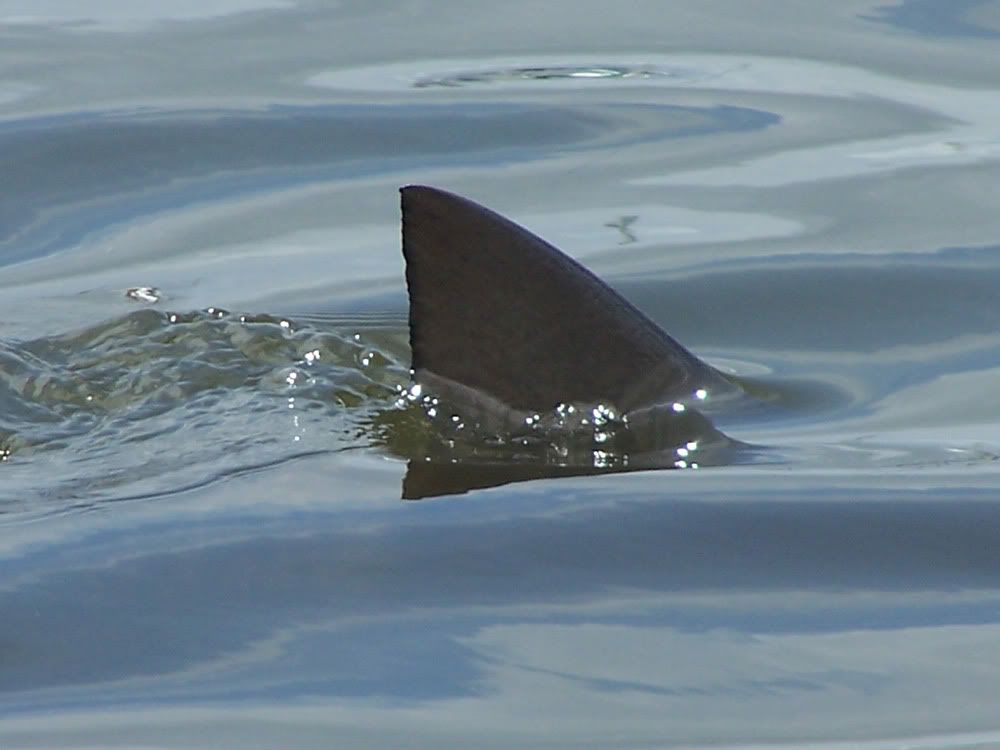
Shark Attacks Woman In Less Than 2 Feet Of Water
http://www.local6.com/news/13435857/detail.html
A large bull shark attacked and injured a woman as she stood in less than 2 feet of water at a South Carolina beach.
Susan Dornquast, who is from Texas, said she was standing near shore at Murrells Inlet in South Carolina when the shark came out of the water and bit her leg.
"I just turned around to look at the waves coming in and that is when the shark came up," Dornquast said. "I felt it hit my leg and thought that was more than water. I looked down and saw the shark swimming off.
Dornquast said she knew the shark bit her after she had trouble moving her leg.
She was taken to a hospital, where she received 40 stitches, the report said.
From the size of the bite mark left on Dornquast, doctors estimate the shark was 5 feet long.
"I could not imagine (a shark) that big coming up to shore like that," Dornquast said. "I didn't know that much about sharks."
"Sharks, especially like the bull sharks we have here, tend to feed in shallow water," marine biologist Paula Branshaw said. "Usually (the bites) are a case of mistaken identity."
Marine biologists said the chances of being attacked by a shark are 1 in 11.5 million.
Last year, there were 23 shark bites in Florida, according to the University of Florida.
Shark Attack
If Florida's sharks are too scary, there's always the pool
http://www.earthtimes.org/articles/show/67131.html
Naples, Florida- In the shark experts' view the German swimmer did everything wrong.
The 68-year-old went for a swim one recent morning in the waters off Naples, Florida, letting the warm Caribbean currents carry him nearly 100 metres from the beach. Without noticing he was in danger, the man felt a sharp blow on his leg.
He swam back to the beach and when he emerged from the water, he discovered a large, bloody injury in a circular shape on his thigh. A male shark that experts estimate was about 2 metres long had bitten the man with its razor sharp teeth.
Everyone is aware that sharks are out there in the warms waters off Florida's coast, said lifeguard Ben Tadler, who works at Marco Island Beach near Naples, Florida. Anyone who is afraid can swim in the pool, he added. Tadler said the German swimmer broke almost every rule of shark protection. First, he was alone, second, he chose to swim early in the morning and third, he swam far from the shore.
Sharks typically seek their prey in the morning and evening, although contrary to the fantasies of Hollywood directors, normally they don't hunger for human flesh.
George Burgess, a renowned shark expert at the University of Florida, said the incident appeared to be an error on the shark's part. When sharks attack people they believe they have come upon a seabird or dolphin.
Burgess, however, can attest to the fact that nowhere in the world are there more shark attacks than along the heavily visited coasts of Florida. More than one-third of all shark attack worldwide are reported here.
In the first months of this year several people were injured in shark attacks off Florida, some seriously, including a 9-year-old boy who was not far from shore off Hutchinson Island when he was attacked.
Even though the recent incident off Naples was officially only the eighth shark attack along that section of coastline since 1882, water safety officials were alarmed and warnings went up.
The message was, "Enjoy the beach, just remember that it's their (the sharks') water, too," Michael Bauer, Naples natural resources manager, told the Daily News, a local newspaper.
People everywhere in Florida are talking about how to avoid a shark attack. Don't swim alone, don't swim far from shore, don't go into the water with shiny jewelry or open wounds and finally, avoid murky water, according to the advisories.
At the same time authorities are trying to reassure the public and prevent panic. They remind people that the likelihood of a shark attack statistically is extremely slim.
Sharks have not become more aggressive than before, said Burgess. There simply are more attacks because many more people are enjoying activities in the water like surfing, deep sea diving and swimming far from shore.
Thus far in 2007 the International Shark Attack File (ISAF) at the University of Florida in Gainesville has registered about two dozen shark attacks.
Worldwide in 2005 and 2006 there were 60 unprovoked attacks in each year. These were incidents that occurred in the sharks' hunting territory without any attempt to touch, follow or otherwise provoke the shark. In each of the past two years four people were killed by sharks.
The number of registered shark attacks, however, has increased since the 1990s, according to the ISAF, even though the number of sharks in some places has dramatically decreased due to overfishing and pollution. There also is an unknown number of unreported cases, particularly in poor parts of the world.
In the past several decades there have been 500 shark attacks officially reported off Florida; 13 of them were fatal. Surfers are at the greatest risk, according to the experts. In addition there are indications that the number of sharks in the warm waters off Florida is growing.
Gene Maxwell, a local fisherman, told the St Petersburg Times that he had discovered many large sharks while fishing about 100 metres from the shore in water just one metre deep.
"I had never seen so many big sharks in such shallow water," said the 21-year-old fisherman. "I just couldn't believe it."
In a 2005 incident a beach north of Palm Beach, Florida, had to be closed to bathers temporarily because of a shark invasion.
Florida's shark experts also say people who find themselves under attack by a shark should not remain passive, but should hit the shark on the nose or in the eye. Sharks respect size and power, they say.
Surfing Shark Attack
Avoiding Shark Attack
http://www.npca.org/marine_and_coastal/marine_wildlife/avoid_attack.html
Sharks are unpredictable, and any time you are in waist-deep ocean waters you are in shark country. Sharks rarely attack people, but a few simple precautions can help you reduce the already slight risk.
When in shark waters but no shark is in sight, look out for fins. If you see one fin cutting through the water, that is likely a dolphin. Two fins—one behind the other—are more likely to be a shark, with its back and tail fins above the surface.
Practice these tips to avoid attracting
seen or unseen sharks
Don't carry dead fish when swimming or diving.
Don't swim at night, early in the morning, or early in the evening. These are the times when sharks are hunting.
Stay out of murky water.
Don't wear contrasting colors or flashing objects.
Avoid wading or swimming in offshore sloughs or channels, such as might occur between sandbars, and in waters that drop off steeply to greater depths.
Never molest a shark of any kind, regardless of size.
If you spot a shark
Stay calm, as sudden movements may attract a shark.
Swim calmly and rhythmically back to land or boat.
Keep the shark in sight, particularly if you are swimming underwater. In most shark attacks, the victim didn't see the shark. Sharks seem to shy away from people who look directly at them.
If all else fails, try to look prepared to fight back.
Aussie Diver Escapes the Jaws of a Great White Shark

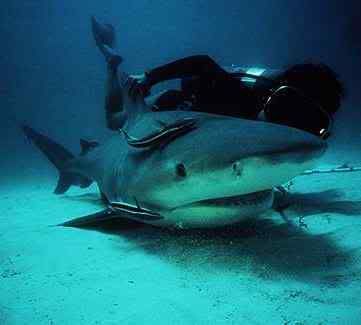
Shark Attack Tips
http://news.nationalgeographic.com/news/2004/08/0804_040804_shark_attack.html
There were only 61 confirmed unprovoked attacks by sharks on humans worldwide in 2004, according to the International Shark Attack File (ISAF). Only seven people people died: including two in Australia and one each in California, Hawaii, South Africa, and Brazil. (The location of the remaining fatality was not specified.)
Still, the threat, however small, is real. And the best way to prepare yourself for a possible shark encounter is to know how to avoid an attack, what to do if you are bitten, and how to help attack victims.
HOW TO AVOID AN ATTACK
• Stay away from the mouths of rivers after heavy rains, when freshwater fishes and other animals are swept out to sea.
• Swim clear of fishing boats. They often trail fish remains and blood, which can draw sharks.
• If you're bleeding, including menstruating, stay on the beach. Sharks can smell and taste even the smallest amount of blood from over a mile (1.6 kilometers) away and trace it back to its source.
• If you cut or injure yourself in the water, get out! Do not stay in the water with blood around you.
• Stay out of the water if fish blood or baitfish are present. In other words, steer clear of fishers.
• Avoid large groups of fish, seals, or sea lions. They all are prominent on the shark's menu.
• Stay away if you see large groups of dolphins and seabirds. They are attracted to the same food sharks eat. And don't make the mistake of thinking that if dolphins are present, there won't be any sharks around. Dolphins can be prey for large sharks.
• Stay away from dead animals in the water.
• Avoid areas where animal, human, or fish waste enter the water. Sewage attracts baitfish, which in turn attract sharks.
• Stay out of the water at dawn, dusk, and night, when some species of sharks may move inshore to feed on fish. Sharks are well equipped to locate prey even when visibility is poor.
• Avoid murky waters, harbor entrances, channels, and steep drop-offs. These areas are frequented by sharks.
• Do not wear high-contrast clothing (orange and yellow are said to be risky colors) or shiny jewelry (which may appear to be like fish scales). Sharks see contrast very well.
• Refrain from excessive splashing. Keep pets, which swim erratically, out of the water. Sharks are attracted to such activity.
• Leave the water quickly and calmly if a shark is sighted. Do not provoke, harass, or entice a shark, even a small one.
• If fish or turtles start to behave erratically, leave the water. They may be behaving like that because there is a shark in the area.
• If you feel something brush up against you, get out of the water to make sure that you have not been bitten. There have been reports that shark-bite victims often do not feel any pain.
• Swim, surf, or dive with other people. Sharks most often attack individuals.
• Don't wander too far from shore. Doing so isolates you and places you away from assistance.
• If you are diving and are approached by a shark, stay as still as possible. If you are carrying fish or other catches, release the catch and quietly leave the area.
WHAT TO DO IF YOU'RE ATTACKED
• If attack is imminent, defend yourself with whatever weapons you can, advises the ReefQuest Centre for Shark Research. "Avoid using your [bare] hands or feet if you can avoid it; if not, concentrate your blows against the shark's delicate eyes or gills." A shark's snout is also said to be sensitive.
• If a shark actually gets you in its mouth, says ISAF's George Burgess, "I advise to be as aggressively defensive as you are able. 'Playing dead' does not work. Pound the shark in any way possible. Try to claw at the eyes and gill openings, two very sensitive areas."
• If bitten, try to stop the bleeding. Leave the water as efficiently, calmly, and swiftly as possible. While many sharks will not bite again, you cannot rule out a second attack.
• Get immediate medical attention, no matter how small the injury.
HOW TO HELP A VICTIM
• Remove the victim from the water as soon as possible.
• Even before you leave the water, begin controlling bleeding by pressing on pressure points or by applying tourniquets.
• Protect the victim from cold by wrapping him or her in a blanket to minimize heat loss.
• Once out of the water try not to move the victim unnecessarily. Call for medical help.
Great White Shark Attacks
World Shark Attacks Rise Slightly But Continue Long-term Dip
http://www.sciencedaily.com/releases/2007/02/070214084015.htm
Shark attacks edged up slightly in 2006 but continued an overall long-term decline as overfishing and more cautious swimmers helped take a bite out of the aggressive encounters, new University of Florida research finds
The total number of shark attacks worldwide increased from 61 in 2005 to 62 in 2006 and the number of fatalities remained stable at four, far below the 79 attacks and 11 fatalities recorded in 2000, said George Burgess, director of the International Shark Attack File housed at UF’s Florida Museum of Natural History.
“This was a nice dull year and we love dull years because it means there are fewer serious attacks and fewer victims,” Burgess said. “It’s really quite remarkable when you have only four people a year die in the mouth of a shark and puts in perspective how small shark attack is as a phenomenon.”
Fewer sharks are swarming near the shore where humans swim as larger numbers of shark and other fish of prey are killed each year, Burgess said. At the same time, many Third World countries are making strides in improving medical care and beach safety, while many people are getting smarter about where and when to get into the water, he said.
“They’re starting to see that when they enter the sea, they’re engaging in a wilderness experience as opposed to entering the equivalent of a backyard pool,” he said.
As a result, the rate of attacks has actually declined over the years as human population has increased, he said.
The number of attacks in the United States, the world’s leader, dipped slightly from 40 in 2005 to 38 in 2006; well below the 53 recorded in 2000, he said.
As in past years, Florida was the world’s shark capital, with 23 attacks, Burgess said. This was slightly higher than the 19 cases reported in 2005 but considerably lower than the annual average of 33 between 2000 and 2003, he said.
Elsewhere in the world, Burgess tracked seven attacks in Australia, four in South Africa, three in Brazil, two in the Bahamas and one each in Fiji, Guam, Mexico, New Zealand, Puerto Rico, La Reunion, Spain and Tonga.
The four fatalities were in Australia, Brazil, La Reunion and Tonga. The Australian victim was a woman swimming with her dog, and the attack may have been provoked by fishermen throwing bloodied fish in the ocean as they cleaned their catch. The Brazilian fatality was a male surfer in waters off the northeastern part of the country. The Tonga case involved a 24-year-old female swimmer who was an American Peace Corps volunteer. The attack off the Indian Ocean island of Reunion was on a 34-year-old male surfing in an area where swimming and other recreational activities are forbidden.
With globalization, not all people are taking precautions as they venture into remote corners of the world that once were sleepy villages with strictly native populations, he said.
“Some of these tourists bring their aquatic recreation to places known to be sharky without asking the natives about good and bad places,” Burgess said. “The natives may know that you don’t go into the water off a certain point because that’s where the big tiger shark is, and the French tourist who decides to go sailboarding there gets grabbed by the tiger shark.”
Surfers and windsurfers were the most frequent victims in 2006, accounting for 26 of the shark attacks, followed by swimmers and waders, 21, and divers and snorkelers, five.
Besides Florida’s 23 attacks, elsewhere in the United States attacks numbered four in South Carolina; three each in Hawaii and Oregon; two in California; and one each in New Jersey, North Carolina and Texas.
“Within Florida, Volusia County and particularly New Smyrna Beach is the hot spot,” he said. “This area on a square mile basis has more attacks than anyplace else in the world.”
A nearby inlet draws many swimmers, surfers and sharks, which find all the splashing, kicking and other movements humans make in the water highly provocative, Burgess said.
Shark attacks in Volusia County increased from nine in 2005 to 12 in 2006. Numbers of attacks recorded in other Florida counties were three in Brevard, two each in Manatee and St. Lucie and one each in Collier, Monroe, Indian River and Palm Beach.
“Even though there are a large number of attacks in Volusia County and along the entire east coast of Florida, the injuries are seldom very serious and fatalities are highly unusual,” he said.
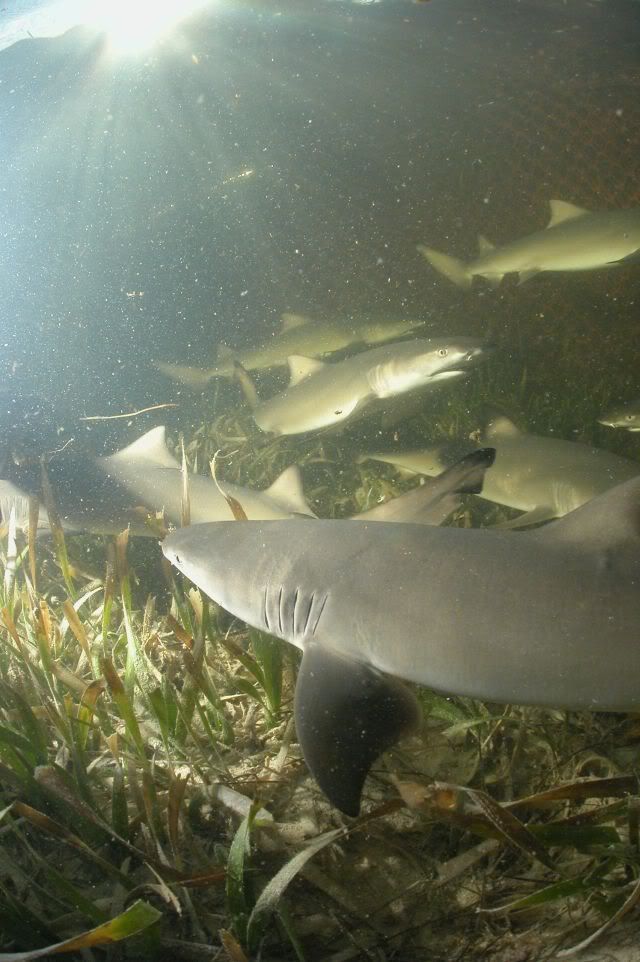
Why Can't We Be Friends?
A horrific attack raises old fears, but new research is revealing surprising keys to shark behavior
http://www.time.com/time/2001/sharks/cover.html
Sharks come silently, without warning. There are three ways they strike: the hit-and-run, the bump-and-bite and the sneak attack. The hit-and-run is the most common. The shark may see the sole of a swimmer's foot, think it's a fish and take a bite before realizing this isn't its usual prey. It swims away, leaving the bleeding victim in need of stitches. The bump-and-bite is far more serious. Last year Chuck Anderson was training for a triathlon off Gulf Shores, Ala., when he was bumped by a bull shark, testing whether he was preyworthy. It decided that he was and then repeatedly attacked Anderson. He lost an arm.
Then there's the sneak attack. The shark is in the right place to find its prey, it is the right time to feed, and the target is the right size. At sunset on July 6 off Pensacola, Fla., Jessie Arbogast, 8, apparently fit the needs of a bull shark. Dusk is one of the shark's feeding periods; the boy was in the shallow water where the bull prowls; and splashing about, Jessie may have seemed to be a large fish. The shark pounced. The ensuing attack and the boy's struggle to survive have stirred an inchoate fascination — part fancy, part dread — with nature's sleekest predator.
Suddenly reports of shark attacks — or what people thought were shark attacks — began to come in from all around the U.S. On July 15 a surfer was apparently bitten on the leg a few miles from the site of Jessie's attack. The next day another surfer was attacked off San Diego. Then a lifeguard on Long Island, N.Y., was bitten by what some thought was a thresher shark. Last Wednesday a 12-ft. tiger shark chased spear fishers in Hawaii. News crews stood on the sand to interview experts, who declared over and over that sharks killed only 10 people worldwide in 2000. But don't swim at dusk or dawn; avoid murky water and steep drop-offs; shed all jewelry. And do swimsuits in yellow — "yum-yum yellow" — attract sharks? No one was sure. Sharks don't give interviews.
Shark attacks have been on the rise in recent years. But for all the terror they stir, the numbers remain minuscule. Worldwide, there were 79 unprovoked attacks last year, compared with 58 in 1999 and 54 the year before. Two-thirds were in U.S. waters. The higher numbers may reflect more surfers, boogie-boarders and open-water swimmers — more people splashing around, hence more attacks. Volusia County, Fla., holds the state record for attacks because its long coastline and many beaches are increasingly packed with bathers from the booming cities of central Florida.
Humans are much more dangerous to sharks, which tend to end up in soup or medicine. Fishing nets tangle and drown about 100 million sharks each year. In California there is only one shark attack for every 1 million surfing days, according to the Surfrider Foundation. You are 30 times as likely to be killed by lightning. Poorly wired Christmas trees claim more victims than sharks, according to Australian researchers. And dogs — man's best friends — bite many thousands more people than sharks do.
But these are terrestrial and mundane risks. Sharks lurk in the vast, mysterious ocean, an element that still stirs mythic fear. Science is shedding light on why sharks behave the way they do. Researchers are tracking sharks via satellites and coming closer to understanding why they attack humans. The three large sharks that account for most attacks on people — the great whites, the tigers and the bull sharks — have been studied extensively. We now know that great white sharks keep their blood warmer than the surrounding water, that tiger sharks do not return to the site of an attack to prey again, and that bull sharks have the highest levels of testosterone measured in any creature, land or sea. Each has a different diet, a different behavior pattern and a different mode of attack.
Scientists ultimately hope to de-mythologize sharks, to erase their images as rogue man-eaters like the great white shark that figures in Jaws, the Peter Benchley novel turned Steven Spielberg movie classic. Benchley, who says he is now "a full-time ocean conservationist," told Time last week, "I couldn't write Jaws today." After 25 years of research, the demonization of sharks doesn't hold, he says. "It used to be believed that great white sharks did target humans; now we know that except in the rarest of instances, great white shark attacks are mistakes." Dr. Robert Lea, a marine biologist working for the state of California, goes further: "I used to call them shark attacks — now I call them incidents. It is not a case of sharks preying on humans. It is just humans sharing a spot in the ocean with sharks — at the wrong time."
Sharks are one of nature's ultimate designs, tested over 400 million years — confident, sleek and lethal (see graphic). Studies show some sharks can measure changes in electric currents as tiny as five-billionths of a volt. They use this ability to hunt for prey hidden under the sand and to navigate according to the earth's magnetic field. "They are like some high-tech AWACs thing, with all their sensors," says Sean Van Sommeran, executive director of the Pelagic Shark Research Foundation in Santa Cruz, Calif. When they do attack a human, the weight of evidence now suggests,they have mistaken a person for a seal or some other prey, and most often will spit out human flesh after the first bite. The problem is, of course, that the one bite comes from jaws that are up to 3 ft. across and lined with hundreds of knives.
THE GREAT WHITE

Scott Yerby never saw the great white shark before it attacked him as he surfed off Clam Beach near Eureka, Calif. "This thing jumped me — it had enough force to lift me right out of the water. It was on my leg, I could see my femur, there was blood in the water — I knew then it was pretty serious," says Yerby, who was 29 at the time of the August 1997 attack. He hit the shark on the nose (the prescribed last-ditch defense, along with ripping at its gills), managed to get back on his board, and with his surfing buddy, paddled back to shore. By the time an ambulance got him to the hospital, doctors said, he had lost almost half the blood in his body and was close to death. As he recovered from his wounds in the hospital, many of Yerby's visitors asked him if he intended to go out and hunt down the shark that attacked him. "I said I had no reason to — he was in his element," says Yerby.
The great white is perfectly adapted to its element. Sometimes growing to more than 20 ft. long and up to 4,000 lbs., it keeps its body temperature 5šF to 10šF higher than that of the surrounding water by recycling heat from its swimming muscles. This allows great whites to hunt in cooler seas. "It seems to make them more vigorous," says Van Sommeran. The sharks are voracious eaters of seals when they patrol the Red Triangle — a 100-mile strip of California coast from Bodega Bay to Santa Cruz. They have enormous livers to store energy, and can go for months without eating. Nobody has seen great whites mate, but some biologists theorize that after fattening up off the coast, they head into the deep to procreate.
Van Sommeran's team, collaborating with the Point Reyes Bird Observatory and the Hopkins Marine Center at Stanford University, is on the verge of finding where the great whites go after they leave the coast of California in the winter. Since 1999, the biologists have been attaching "pop-up tags" to great whites. These continually measure the shark's position, depth, speed and direction, and store the data in digital archives. After six months, the tiny computer in the tag sends an electric current through a magnesium burn wire, which dissolves in the seawater and allows the tag to pop up to the surface. The tag transmits a GPS locator signal, and when satellites get a fix on it, they upload all the archived data of the shark's movements. The distances are likely to be huge. A shark tagged in Australia in a similar experiment this year traveled more than 1,800 miles along the country's coast in three months.
Great whites are the most lethal to humans. Since 1876 there have been 254 confirmed nonprovoked attacks on humans by great whites, 67 of which were fatal, according to statistics compiled by the International Shark Attack File at the Florida Museum of Natural History. Over the same period, tiger sharks have attacked 83 times with 29 fatalities, and bull sharks have attacked 69 times with 17 fatalities. Great white attacks on humans generally involve just one bite. Researchers are not sure, but most think the shark's sensory organs quickly differentiate between humans and the blubber-rich seals it prefers, so it effectively bites and spits out humans.
Researchers who have been observing great whites off the Farallon Islands west of San Francisco think they know why sharks mistake humans for seals. Peter Pyle, a biologist for the Point Reyes Bird Observatory, notes that the majority of great whites that attack humans are in the 8-to-12-ft. range — inexperienced juveniles making the diet transition from fish to bigger, more nourishing seals. "They are learning a new hunting technique and may mistake surfers for seals," says Pyle. Once the sharks get bigger and more experienced, they appear better able to differentiate between seals and humans.
Unlike tigers and bulls, great whites hunt mostly during the day, and their preferred method of attack is to shoot up vertically from 30 ft. down, knocking their prey right out of the water with the impact. Researchers in South Africa have produced spectacular footage of great whites leaping 15 ft. into the air with a seal in their teeth.
TIGER SHARK
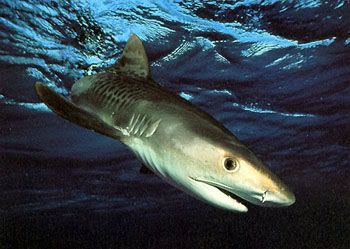
esse Spencer, now 18, from the Big Island of Hawaii, was surfing near Kona in October 1999 when a 10-ft. tiger shark came halfway out of the water and pushed him off his board. The shark's nose struck Spencer's head, then its jaws locked onto his arm. "I could almost see the whole shark. My elbow was down his throat." The shark ripped muscles, tendons and blood vessels, then chomped down on the surfboard before finally disappearing. Spencer made it to shore, and today his arm is recovering, although he still cannot grip with his hand. His mistake? Surfing at sundown.
The tiger shark generally hunts at night. It is an indiscriminate eater, "willing to try anything for food," says Rocky Strong, a shark biologist associated with the Jean-Michel Cousteau Institute. Not just fish, turtles and sea mammals but also dogs, boots, beer bottles and unopened cans of beans. Its teeth are serrated, with a notch to catch and cut through ligament or shell tissue.
Tiger attacks on humans have been on the increase in Hawaii, and one reason, says John Naughton of Hawaii's Habitat Conservation Program, may be the increase in seagoing green turtles since they were protected in the 1970s. "Turtles come close to the shore, and the tigers follow them to prey on them. That puts them in the same area as swimmers and surfers." Tigers are slower swimmers than great whites and not as good at surprise. Human victims often see the shark before it closes in to attack. But tigers are persistent. "If you are bitten by a tiger, you have a good chance of being chewed up. They come back," says John McCosker, a scientist at the California Academy of Sciences.
After a spate of attacks in Hawaii in the early '90s, islanders headed out to kill the rogue tigers. But scientists have since learned that tigers are not territorial, and so chances of catching the culprit at an attack site are minimal. Dr. Kim Holland of the Hawaii Institute of Marine Biology at the University of Hawaii has been monitoring tiger movements with the CHAT (Communicating History Acoustic Transponder) tag. Implanted in belly walls to log the shark's position and depth, the CHAT tags upload their information to underwater receivers, usually placed in shallow bays, which are retrieved every three weeks. "We know they don't stake out declared territories. They are inter-island travelers," says Holland.
BULL SHARK
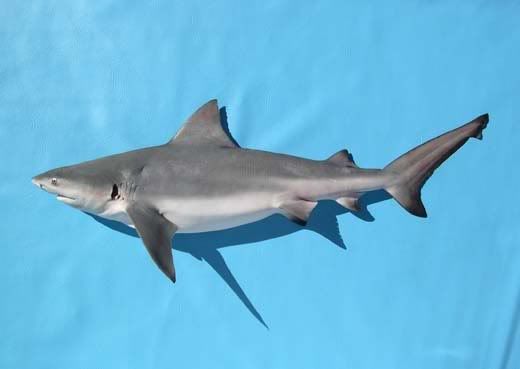
When Dawn Schauman was attacked by an 8-to-10-ft. bull shark in October 1993, she said, "it felt like a truck had slammed into me, then I felt a compacting squeeze and an acute burning in my left hand and my left leg." The shark spun her around, leaving her disoriented as she hemorrhaged blood into the water. The shark left, and willpower alone got Schauman — 61Ž2 months pregnant — back to shore. Her baby was later born prematurely but safely. For months Schauman woke at 3 a.m. replaying the attack in her head.
The bull shark, Carcharhinus leucas, usually grows no longer than 10 ft. and weighs up to 500 lbs., but what it lacks in size it makes up for in aggressiveness. Experts regard it as the most pugnacious of sharks. It has, according to Robert Hueter, director of the Center of Shark Research at the Mote Marine Laboratory in Sarasota, Fla., the highest level of testosterone in any animal, including lions and elephants. Its lower spiked teeth are designed to hold prey while the upper triangular serrated teeth gouge out flesh. "The bull is an ambush type of predator, it makes this big mortal wound," says Hueter. It is fearless, taking on prey as large as it is.
A unique feature of bull sharks is their ability to live in both salt- and fresh water; they have attacked people in Lake Nicaragua in Central America and have been seen above St. Louis, Mo., in the Mississippi River. Those born in the Mississippi delta usually spend about six months in the brackish water before migrating along the coast to Florida to winter in the Keys.
The bull is the only shark that prowls regularly in water shallow enough for humans to walk in — and it may be territorial. Australian shark biologist Ian Gordon has been getting into the water off Florida beaches and deliberately agitating bull sharks to observe their reaction. He says his research so far suggests that underwater geography and a sense of territory can provoke an attack. "Even if you don't know it's there, the shark will feel like it is being cornered."
Human shark victims almost always seem to be inadvertent intruders rather than targeted prey. Scientists who work with sharks know how dangerous they can be, and many are critical of the guided shark-feeding tours that are proliferating in Florida and the Bahamas. Sharks there have begun to associate the sound of an outboard motor with food, and there have been attacks by sharks apparently impatient to be fed, according to George Burgess, head of the International Shark Attack File. Shark feeding is illegal in two Florida cities, and a campaign to ban it statewide is under way. "When you are training animals, you are changing their basic behavior and their respect for human beings," says Burgess.
That would be a strange development: the ocean's fearsome hunters lured unnaturally into the company of humans — then learning to bite the hands that feed them. Nature has its bounds.
CNN Report: Shark attack caught on tape
Shark Attack Victims
http://www.sharkattackphotos.com/Shark_Attack_Victim.htm
Shark Survivor Interviews
http://sharksurvivor.com/interviews.html
Horrible Shark Bite
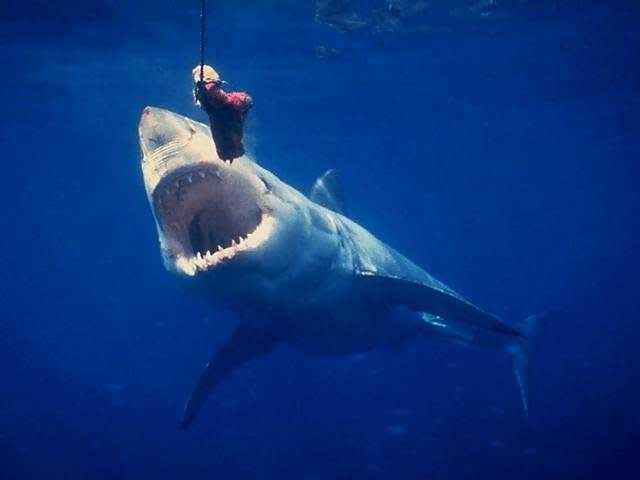
Great White Shark Attacks Inside Cage!!

A swimmer in the waves off a beach is attacked by a shark
White Shark & Seal
National Geographic Wild Chronicles : Whale Sharks
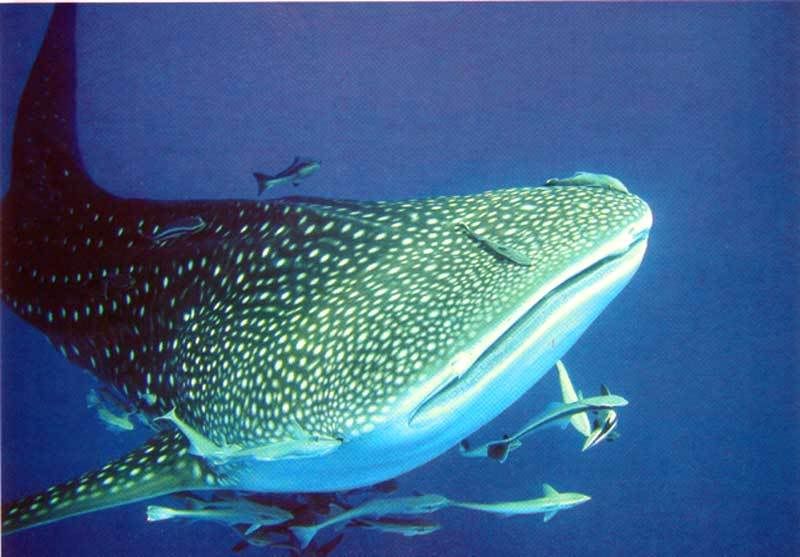
Hammerhead Attacks a Tarpon















![Brotherhood" (2006) [TV-Series]](http://photos1.blogger.com/x/blogger2/1421/379621144723082/211/z/425926/gse_multipart33129.jpg)







No comments:
Post a Comment